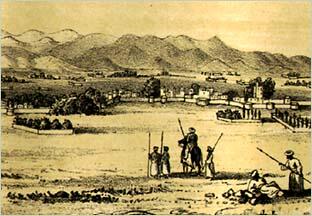Above: View of Jelalabad [Afghanistan] from the South, Frontispiece to Narrative by Charles Masson (1842)
Charles Masson was a deserter from the East India Company's Bengal Artillery. One day in 1827 he suddenly left his regiment at Agra with a fellow soldier. They headed west, towards the Indus River and lands not yet under British control.
During many years of wandering, he stumbled on the ruins at Harappa in the late 1820's. He became the first European to report their existence in his book Narrative of Various Journeys in Balochistan, Afghanistan and The Panjab (London, Richard Bentley,1842).
Masson is best known as a numismatist whose unearthing of various coins provided the first new clues to the Bactrian Greek and Kushan Empires which once ruled Afghanistan and Punjab. His desertion was ultimately forgiven. He played some intelligence role until falling out again with his superiors over the conquest of Kalat in Baluchistan.
Masson's visit to Harappa was brief. The book's few illustrations are by his own hand. One of these illustrations may have much more to do with the Harappans than he could have known.
His engraving of the Citadel in Kalat may give some indication of what a citadel in Harappa looked like. Kalat is about 100 miles northwest of Mohenjodaro, and is the home of the Brahui people. The Brahuis are the only Dravidian speakers left near the Indus Valley. There are also Brahuis near Mohenjodaro, suggesting that they played some role in ancient Indus society.
Masson retells a Brahui folktale in his book. He was one of the first people to recognize that Baluchistan was full of unexplored mounds. If the Brahuis did end up in Baluchistan, they may have come from there as well. Recent research shows striking resemblances between the pottery and script of the Harappans and people in much earlier urban Baluchi settlements like Mehrgarh, not far from Kalat.

